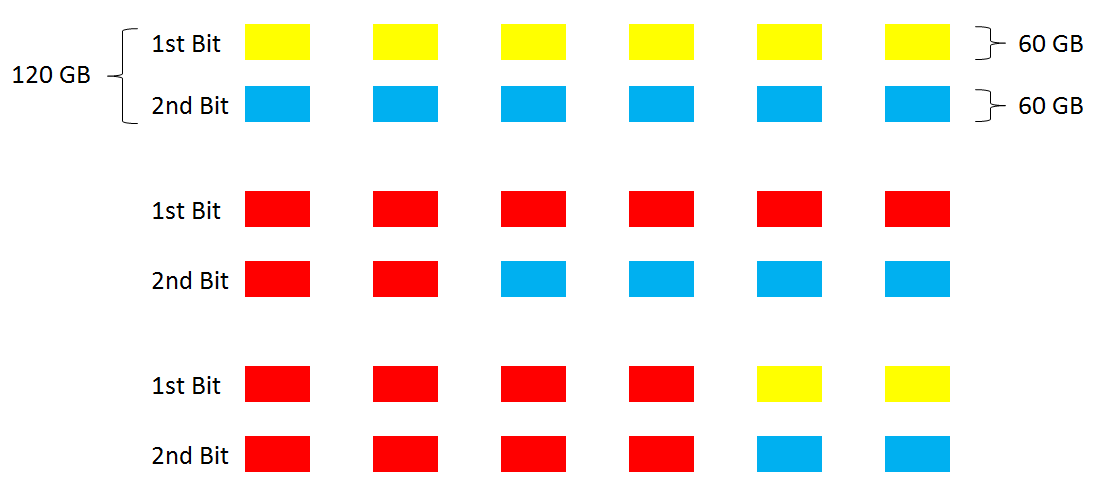OCZ Vertex 4 128 GB: Revisiting Write Performance With Firmware 1.5
In our recent look at the Vertex 4 SSD equipped with firmware 1.4, we found that the 128 GB drive's write performance depended heavily on available capacity. OCZ disagreed, but then quickly rolled out firmware 1.5. So, we're back to test the new build.
Our Theory About How v.1.4 Changed Write Performance
Consumer based SSDs typically use multi-level cell (MLC) NAND, which (typically) stores two bits per cell. This effectively doubles the amount of storage space compared to single-level cell (SLC) NAND, limited to one bit per cell.
Writing two bits to a cell comes at a price, though, as it takes longer to program than SLC NAND. When you're talking about MLC NAND, each bit of a cell is programmed separately. The first bit is relatively fast and easy to program, while the second is more complicated, taking three to four times longer. Consequently, there's a significant performance difference between writing the first and second bits.
When you only write to one bit of an MLC NAND cell, performance is very similar to what you'd see from SLC flash. This is referred to as SLC mode. If you only write one bit to each cell across an entire consumer SSD, though, capacity would be cut in half. If you want to use more than 50% of the available capacity, you cannot operate in SLC mode exclusively.
Let’s consider a 120 GB drive built using MLC NAND. In SLC mode, only 60 GB worth of bits are available to program, and writing that capacity consumes 100% of the accessible bits. In order to write any more, the second bit of each cell has to be programmed, forcing the drive to shift into MLC mode. When this transition occurs, write speeds drop significantly because only the second (slower) bit of each cell is available.
Now, let's say that the same 120 GB drive has 80 GB worth of data on it. If that information is rearranged so that it occupies two bits per cell instead of one, the drive can shift back into SLC mode. This time, however, it only has 20 GB worth of space that can be programmed using that faster mechanism.
Our scenario is represented in the image below. The drive, completely empty, starts with 60 GB of capacity that can be written in SLC mode. You write 80 GB to it: the first 60 GB are written quickly, and the next 20 GB are written more slowly, in MLC mode. After the write operation, the drive consolidates data in the background, leaving 20 GB for operation in SLC mode once again.
This behavior seems very similar to what we're seeing from OCZ's Vertex 4, which employs MLC NAND. We could be wrong, of course, but the performance drop, resumption, and drop again appear consistent with the drive cleaning itself up to give you access to an SLC mode whenever it can. Transitioning back and forth, in theory, allows written information to be consolidated, freeing up more space.
Get Tom's Hardware's best news and in-depth reviews, straight to your inbox.
If that is what the Vertex 4 is doing, firmware 1.5 appears to have improved the efficiency of the background processes that free up cells, enabling a faster switch back from MLC to SLC mode. Ultimately, though, SLC mode is, by definition, only able to operate within a percentage of whatever free capacity is available.
Should our theory prove correct, OCZ's Vertex 4 adds a new and interesting variable to the way SSDs perform.
Current page: Our Theory About How v.1.4 Changed Write Performance
Prev Page Firmware 1.5: Iometer Test File Monitoring Next Page Firmware 1.5: Something Special For OCZ's Vertex 4-
DeusAres Good idea I suppose. Nothing that's going to particularly influence my decision. Probably gonna be sticking with either a Crucial or Corsair SSD. :)Reply -
mayankleoboy1 on pages 6 and 7, the author of the article is shown as "Chris angelini"Reply
the rest of the pages show "Richard Hart" -
mayankleoboy1 does the rearrangement of data occur only during a reboot cycle?Reply
how much idle time is needed for the data rearrangement to take place?
And what is the authors recommendation on a Vertex4? should a user buy Vertex 4 over a Samsung/Sandforce? -
lutel Does this SDD support full disk encryption with any of the Intel desktop mainboards (Ivy Bridge)? AFAIK Intel is not supporting FDE since Q67 and although Q77 is capable of FDE, there is no mobo with BIOS that can support it. Could Tomshardware investigate it?Reply -
TheSandman So keep the disk under half full and it wears out twice as fast?Reply
Does the performance mode mean that the wear leveling is constrained to the first bit of every cell and therefore the drive wears out quicker compared to normal mode?
-
I went from firmware 1.3 to 1.5, the performance increase is huge, but the down side is that the drive is not 128GB anymore but only 120GB. Has anyone else seen this issue also? Did OCZ reserve more spare?Reply
-
redgarl AnonymousI went from firmware 1.3 to 1.5, the performance increase is huge, but the down side is that the drive is not 128GB anymore but only 120GB. Has anyone else seen this issue also? Did OCZ reserve more spare?It is actually occuring with update 1.4. Hmm, damn I need to do another clone disk before doing the update.Reply -
kissingman Bother! I just purchased one.The more worse is this one has updated to firmware 1.4.Reply -
blazorthon JohnnyLuckyHow many additional firmware updates are needed before OCZ gets it right?Reply
Do you dislike manufacturers improving their products without demanding that you pay more money for the improvements?
